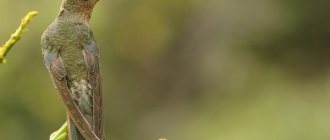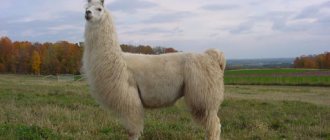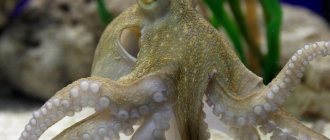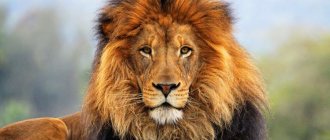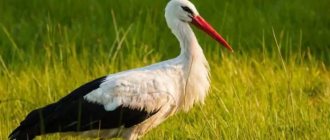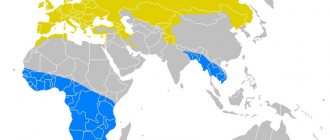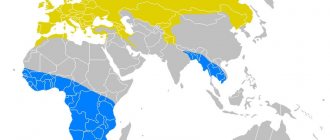Hummingbirds are very amazing birds that are so small that they look more like bees. There are 330 species of these tiny birds living in nature. They are related to our swifts, which are giants in comparison.
Purple Saberwing (Campylopterus hemileucurus)
The size of a hummingbird is no more than 2! centimeters, weight - no more than 5 grams. But there is also a giant among these birds - the giant hummingbird. Its length is almost 20 centimeters. However, 1/2 of the length is the tail.
These birds are the smallest among vertebrates. In proportions, the body resembles the structure of our sparrows. But hummingbirds have very small and weak legs, so they cannot walk on the ground. And sitting on branches takes a lot of strength from them: the bird clasps the branch with both legs, and does not just sit on its paws.
White-tailed Inca (Coeligena phalerata) on a branch
The hummingbird is a bird of flight. They remain in this state almost their entire lives. They are forced to constantly look for food, because their energy consumption is very high.
Hummingbirds do not have hovering or gliding phases in flight. They are forced to flap their wings at a frequency of 100 times per second. Otherwise they will fall to the ground. It’s not difficult to calculate how many calories this requires – a lot! That is why they scurry around the flowers in search of nectar - their main delicacy.
Hummingbird wings are more similar in structure to the wings of butterflies than birds.
Hummingbirds have special wings, not like all birds. They are more similar to butterfly wings. And also a huge heart, almost half the size of the whole body. And all this in order to withstand the loads of flight.
If a hummingbird stops feeding for even half an hour, it will die from exhaustion. This baby's metabolism is incredibly fast!
Description
The body length from beak to tail is only a few centimeters, and the weight is two grams. This little bird is lighter than one ostrich feather! The size of a newly hatched hummingbird chick is approximately 0.5 cm. This baby has very colorful feathers.
Hummingbird chicks
In males, the feathers are green; against this background, a bright red neck, a dark gray belly, and a bluish-blue back stand out. Females are distinguished by a rich white tail, the back, like the males, is green, and the lower part of the body is slightly lighter and has a gray-white color.
Banana warbler (11 cm)
The banana warbler is the symbol of the Virgin Islands (USA). The length of this small bird is only 11 cm. These birds from the order of passeriformes love sweets: they suck nectar from flowers, juice from soft fruits and berries. This addiction earned them the nickname “sugar birds.” They often diversify their diet with insects and arachnids. These small birds live in the tropical thickets of South and Central America. The characteristic color is a yellow belly and light stripes on the sides of the gray head.
The banana warbler's nest is spherical or ellipsoidal in shape with a lower side entrance. A house made of dry leaves and blades of grass and leaves is not afraid of rain. Females lay up to 3 eggs twice a year. The male nests separately, nearby. He helps the female hatch eggs and feed the chicks.
What is a hummingbird?
Feeding of hummingbirds
It is a mistaken belief that hummingbirds eat exclusively flower nectar. Birds need a lot of protein, so their diet mainly consists of midges, flies, mosquitoes and spiders. On a day, hummingbirds consume an amount of food that is twice the weight of the bird itself, thanks to which the winged creatures can maintain an accelerated metabolism and stable temperature of their tiny bodies.
Interesting: Eagle - description, characteristics, hunting, vision, families, photos and videos
About every five to ten minutes, a hummingbird eats something. If we were to create a top list of the most insatiable birds, the hummingbird would take the gold. When collecting nectar, the tiny creature flies from one flower to another, thereby pollinating them. This is the “job” of the hummingbird.
The weight of the smallest adult hummingbirds is not even three grams.
2. There are 330 species of hummingbirds in the world, with the vast majority being very small, brightly colored birds.
3. Nature researchers awarded very beautiful names to the representatives of this family: “angel hummingbird”, “snow-capped hummingbird”, “coquette hummingbird”, “emerald throat”, “fiery topaz”, “flying amethyst”.
4. Hummingbirds are found in a wide variety of climates: Arizona, the coast of Nova Scotia, Argentina, even Alaska.
5. At first glance, these birds are very delicate and fragile, however, they are the hardiest in the entire animal world. During migration, hummingbirds are able to travel a thousand kilometers in less than 24 hours.
Gigantic hummingbird
6. The largest of the hummingbirds are the gigantic hummingbirds; the size of these birds reaches 21 centimeters and weighs 20 grams.
7. There are no hummingbirds in Russia, but you can see them with your own eyes in zoos and ornitariums.
8. The only time hummingbirds were found on the territory of the Russian Federation. The buffy hummingbird was discovered in 1976 on Ratmanov Island (Bering Strait).
9. Hummingbird is the only bird that can fly backwards or upside down.
10. Hummingbirds only feed while in the air.
"Hummingbird Bee"
11. The smallest hummingbird is called the “bee hummingbird”; this bird is only 7 centimeters long and weighs 2 grams.
12. Scientists say that hummingbirds are simply created for flight. It is hardly an exaggeration to say that hummingbirds are the best fliers in the world.
13. The speed of the hummingbird's wings is enormous - about 50-80 beats per second. But this is not the limit.
14.The speed of a small bird reaches 80 km/h, which is really a lot for such a small creature.
15. When courting a female, the male of one species of hummingbird makes more than 200 strokes per second. Acceleration to maximum speed and instant stopping in these birds occurs almost instantly, in just a few seconds.
Sword-billed hummingbird
16. The beak of a hummingbird is thin and long, sometimes very long; for example, in the sword-billed hummingbird, the beak is longer than the entire length of the bird (i.e., head, neck and body). Thus, this species of hummingbird turns out to be the longest-billed bird in the world.
17. The hummingbird's diet consists of flower nectar and small insects.
18. To obtain the required amount of food, hummingbirds use their long beak, which can penetrate deep into the calyx of a flower.
19. Some species of hummingbirds do something even more original, piercing the base of a flower with their beak if they cannot get to the nectar in the usual way.
20. A long tongue with a special shape is also used to extract nectar. This form helps the nectar stay on the tongue while the hummingbird decides to feed. The nectar is captured by the tongue and, thanks to the shape of the tongue, goes directly into the throat.
Ruby-throated Hummingbird
21. The ruby-throated hummingbird migrates from Canada to Mexico and Panama for the winter. The flight distance is 5000 kilometers.
22. Average flight speed is about 50 kilometers per hour. Not all large birds are able to withstand such a long and grueling flight, not to mention small birds.
23. Hummingbirds have a huge heart, by their standards - it is three times larger than the stomach, and occupies more than a third of the volume of their entire body.
24. The heart of a hummingbird beats 500-1000 times per minute, and during its life it contracts about 4.5 billion times.
25. Hummingbirds have several times more red blood cells than other birds.
26. Hummingbirds can hover motionless over a flower almost vertically. This is a unique property. In the whole world, only the hawk moth bird can do this.
27. Hummingbirds are superior to the vast majority of birds in the art of flight. And the structure of their body, the structure of their wings is different from all other birds.
28. In order to be able to flap its wings so quickly, hummingbirds must have short and straight shoulder and forearm bones. The wing bones are strong and light due to the fact that they are hollow.
29. The structure of the hummingbird’s wing itself is very rigid due to the fact that a number of joints simply do not move.
30. Their shoulder joints are flexible, so they can move in any direction. They can also rotate approximately 180 degrees.
31. Nature has not stinted on the colors of hummingbirds - birds are characterized by bright colors and iridescent shine.
32. Hummingbirds have an original feature - their plumage looks different every time.
33. If at first glance the bird may seem greenish in color, then at the second glance the plumage may sparkle with purple hues - this is a feature of the refraction of light. 33. Hummingbirds can fall into a lethargic sleep. During the day, the body temperature of a hummingbird is 39-40 degrees Celsius, and at night, when the ambient temperature drops, the bird falls into a stupor, its body temperature drops to 18 degrees, and breathing becomes barely noticeable. Thus, the hummingbird reduces energy expenditure. And as morning comes and the air temperature rises, the hummingbird returns to its normal state.
34. The coat of arms of the island nation of Trinidad and Tobago features a hummingbird.
35. When “flying in place,” a hummingbird has to make a figure eight with its wings. Thanks to this, the bird stays upright in the air.
36. Male hummingbirds can be distinguished from females by the original shape of their head and tail feathers.
37. Most hummingbird species nest in trees and bushes; some species, like swifts, stick their nests to rocks or leaves with their saliva.
38. The hummingbird bird very skillfully builds nests from plant fluff, blades of grass, etc. and attaches lichens, moss, etc. to them. The nests are hung from branches or the ends of leaves.
39. The immediate enemies of hummingbirds are the tarantula and tree snakes.
40. To provide their body with enough energy, a number of species of hummingbirds must feed very often - every 10-20 minutes.
41. These little birds never mate. Responsibilities for family affairs fall entirely on the “shoulders” of the female.
42.The female hummingbird builds the nest herself. Then she, as a rule, lays two eggs and very rarely one. The hummingbird egg is the smallest in the world. The eggs are also incubated by one female for 14-19 days.
43. Hummingbird chicks are naked, weak and helpless; they are also fed by one female.
44. Birds can fly even in the rain - this is necessary for their survival. If hummingbirds couldn't fly in the rain, it would threaten the survival of a number of species.
45. Hummingbirds consume about a hundred times more food per unit weight than elephants.
46. It’s a great pleasure to look at these babes. But it’s very difficult to “catch” them on the branches - hummingbirds are constantly on the move.
47. The longest recorded lifespan of hummingbirds is 17 years, but on average they live less, about 9 years.
48. A hummingbird consumes more food per day than its own weight.
49. In hummingbirds, the muscle mass of the wings accounts for about 40% of the total body mass.
50. To provide muscles with oxygen during flight, oxygen is also needed. Hummingbirds get it thanks to their developed respiratory system, which includes 9 air sacs.
Racket-tailed Hummingbird
photo from the Internet
Why does the hummingbird always fly?
Hummingbirds in flight
These birds have very weak legs, which is why they cannot walk, but constantly fly. Because of this, people have the impression that such birds never get tired. At the same time, they fly in any direction and are able to hover in the air in one place, like a helicopter. At this moment, their wings beat approximately 55 times per second.
The wings move so quickly that their outlines blur and become almost invisible. In flight. Gigantic hummingbirds reach a speed of about 115 kilometers per hour, which is a record among birds.
Enemies
Hummingbirds have few enemies. The baby is very active and maneuverable, so not everyone is able to catch it. In nature, only snakes and tarantulas can feast on it, waiting in dense tropical thickets. Humans hunt for beautiful plumage, causing significant damage to the population of certain species.
Scientists have long been working on the problem of artificial breeding of this rare species of birds. For the first time they managed to achieve positive results in 2015. The resulting hummingbird breeding technology will make it possible to restore many populations of this unusual bird.
hummingbird beak
A huge number of species of this family differ from each other in the size and shape of their beaks. It is this factor that influences the choice of plants for pollination. Birds with a small beak find it easier to feed from flatter flowers, while those with a long, elongated beak feed on nectar from narrow, funnel-shaped inflorescences.
Interesting: Interesting facts about Ancient China
Sword-billed hummingbird
The Sword-billed Hummingbird has the longest beak in the family of these birds. Its length can be 10 centimeters, which is twice the size of the bird itself. This hummingbird has emerald-colored feathers, a dark gray belly, and the area behind the eyes has characteristic white pigmentation.
The entire hummingbird family is distinguished by its incredibly beautiful feather color, reminiscent of precious stones, especially when the feathers begin to play with a riot of colors under the bright sun. It is for this reason that the bird is often given poetic names associated with stones: amethyst, topaz, emerald and many others.
Fan-tailed cisticola (10 cm)
The fantail cisticola does not grow longer than 10 cm, making it one of the smallest birds in the world. In color it resembles an ordinary sparrow, splashed with orange paint. In flight, the bird opens its tail like a fan, can dive, and when landing on the ground or blades of grass, it often ruffles itself, turning into a round lump.
It feeds on arthropods (insects, spiders), so it prefers to live near bodies of water near agricultural land. Makes small nests, lays up to 3 motley eggs twice a year. The female and male take care of the clutch together. Hatching lasts up to 11 days, the chicks are fed for up to two weeks.
Social structure and reproduction
Hummingbirds
These wonderful birds do not live in pairs. The female independently raises the chicks and builds the nest. The materials used to build the house are pieces of grass, cobwebs, the fluff of other birds, and small fragments of bark. The parameters of the “housing” are determined by the size of the bird and can be the diameter of half a walnut shell or a tea cup. Basically, the female lays two eggs at a time, less often one. Hatches them for about 18 days. If necessary, a brave mother will boldly defend her cubs, even if the attacker is many times larger than her. The lifespan of hummingbirds reaches approximately 9 years.
Where does it live?
The bird lives in South, North, Central America and on the islands of the Caribbean. Birds live in midlands, tropical forests, temperate latitudes and mountain meadows. Most species prefer warm climates. But the ruby-throated hummingbird can easily tolerate the cold, which is why it nests in Canada.
Most birds do not fly far for the winter and move within one country. These include residents of tropical climates. They stay warm all year round and can find flower nectar for food.
The exceptions are the Chilean fire-capped hummingbird, the common archilochus and the gigantic.
The Aztecs believed that hummingbirds were fallen warriors who returned to Earth in the form of a bird and traveled with the Sun.
Bee
The largest species of hummingbird
Giant Hummingbird
The largest member of the family is the Giant Hummingbird (Patagona gigas). This species can be identified by its brown color with a green tint, as well as its red-brown belly. The body length of a hummingbird of this species can reach 22 centimeters, and its weight is approximately 18-20 grams. In addition to their size, these individuals differ from their relatives in their rather long beak and fork-shaped tail, like a swallow.
Interesting: Flies: nutrition, vision, smell, danger, benefits, types, photos and videos
Hummingbirds are incredibly unique creatures, differing from other winged creatures in their lifestyle and structure, and most importantly, their size. In this regard, for many years it has been of incredible interest to nature lovers.
Heart
This little one has an unusual heart. To withstand the intense stress of flight, its muscles make up 40 percent of the bird's total weight. During the flight, the heart rate increases to 1200 beats per minute.
She is very sensitive to temperature changes. In the evening, its activity decreases and the hummingbird falls asleep. With the first rays of the sun, she awakens and begins her active work again.
Shortbeak (8 cm)
The second place among the smallest birds in the world is taken by the short-billed bird - no more than 8 cm long, weighs up to 6 g. A rare species of the passerine family lives in the crowns of eucalyptus trees and forests of the Australian continent. Small birds with yellowish plumage and a light-colored iris are also called warblers. During the nesting period, males emit overflowing trills, females silently accept courtship. They feed on aphids, small mites and spiders. They live in packs.
Kings (9 cm)
Kinglets, one of the smallest birds on the planet, grow up to 9 cm long and weigh no more than 7 g. These active and voracious birds from the passerine family are called “northern hummingbirds”. Motley, with a bright yellow crest, they are constantly looking for insects, eating up to 4 g per day. Kinglets nest in coniferous forests, mainly on spruce trees. Females lay up to 10 eggs, without getting up for up to 12 days, warming the offspring. The male feeds her. The chicks are cared for together.
In the cold season, they feed on seeds and carrion, join flocks of tits, and share warmth with them in shelters. From the northern regions in the fall, birds migrate to the southern regions, where there are no severe frosts. They adapt well to city conditions and master feeders.
